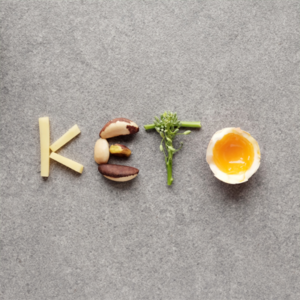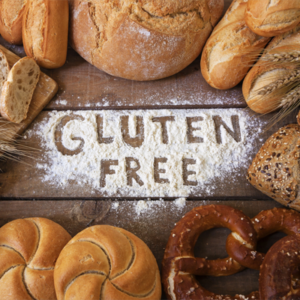
With so many diet programs out there, it is important to understand them. Why did these fad diets come to be and why should they NOT be part of your routine?
Fad diets are any short-term, quick fix that actually sets the dieter up for weight loss failure. Usually, if it restricts whole food groups, limits the quantity and has rigid menus; thus, it is a fad! Most fad diets limit food groups, and in turn, restrict essential vitamins and minerals. This can cause a spike in blood sugar and, of course, lead to rapid weight loss. This can wreaks havoc on metabolism and interrupts the body’s natural set point and ability to burn calories at rest. Let’s take a look at three of the most popular fad diets currently trending:
- Ketogenic (extreme low-carbohydrate, high-fat)
- The Whole 30 (restrictive to observe food sensitivities)
- Gluten-Free
The Ketogenic Diet.
 The Ketogenic Diet, “keto,” was developed to treat severe epilepsy in infants and children under medical supervision. Today the ketogenic diet is moving to the mainstream as a low-carbohydrate tool for weight loss and as a means to reduce cardiometabolic risk factors, but not without controversy.
The Ketogenic Diet, “keto,” was developed to treat severe epilepsy in infants and children under medical supervision. Today the ketogenic diet is moving to the mainstream as a low-carbohydrate tool for weight loss and as a means to reduce cardiometabolic risk factors, but not without controversy.
The ketogenic diet is very low in carbohydrates and very high in fat, forcing the body into ketosis, the burning of fat instead of glucose for fuel. Clinical ketogenic diets limit carbs to 20 to 50 grams per day, primarily from nonstarchy vegetables, with very low-carb ketogenic diets restricting carbs to 30 grams per day. Protein intake is high to maintain lean body mass, but low enough to preserve ketosis. The amino acids alanine and glutamine in protein can be converted to glucose through gluconeogenesis, nudging the body out of ketosis.
The body, deprived of dietary sugar and starch, reduces insulin secretion and switches to primarily burning fat for fuel. The resulting overproduction of acetyl-CoA leads to formation of ketones—beta-hydroxybutyric acid and acetone—in a process known as ketogenesis. Whereas the brain can’t use fatty acids for fuel, ketones can cross the blood-brain barrier, providing fuel to the typically glucose-hungry brain and to other tissues. The transition to physiological, or nutritional, ketosis usually takes a week, and it doesn’t raise blood levels of ketones as high as what occurs with diabetic ketoacidosis.
| Encouraged | Not Recommended |
| Fat (75%-90% of total caloric intake) |
Carbohydrates
|
| Non-starchy vegetables | |
| Protein (10% of total caloric intake) | |
| Pros | Cons |
| Short-term weight loss | Limited options |
| Reduced cravings | Most restrictive |
| Reduced hunger | Time consuming |
| Improved insulin control? | |
| No long-term, large studies | |
| Rules not always followed correctly | |
| Reduced variety likely leads to reduced caloric intake, therefore weight loss |
The Whole 30 Diet
The Whole 30 Diet is a 30-day program focusing on removing entire food groups shown to have negative or inflammatory impacts on the body, causing inconsistent energy levels, unexplained aches and pains, difficulty losing weight, skin issues, digestive ailments, seasonal allergies and fertility issues.
The general idea is that by stripping entire food groups from the diet, the body is able to heal and reset. After the 30-day period, a one-by-one introduction of each food group is required to understand how each affects the body. Historically, most Whole 30 participants do not re-introduce the foods as recommended and instead treat the 30-day period as a more of a “challenge” and restrictive diet to reach max weight loss and return to their “normal” (unhealthy) eating patterns on day 31.
| Encouraged | Not Recommended |
| Vegetables | Grains: wheat, rice, oats, corn |
| Some fruits | Legumes |
| Protein | Soy & soy products |
| Fat from clarified butter (ghee) | Dairy |
| Green beans, snap peas, snow peas | Sugar & artificial sweeteners |
| Alcohol | |
| Condiments with MSG, carrageenan, & added sulfites | |
| Pros | Cons |
| Eat more whole foods | Limited options |
| Cuts out alcohol & refined sugar | Most restrictive |
| Encourages label reading & knowing what is in your food | Time consuming |
| No long-term, large studies | |
| Rules not always followed correctly |
Gluten-Free Diet
 The Gluten-Free Diet was initially created for people diagnosed with Celiac Disease. Gluten is a combination of several complex proteins that are not easily digested by humans. For most people, this incomplete protein breakdown does not cause an issue, but for others with certain genetic susceptibility to gluten-related disorders, undigested gluten damage to the intestine, which impairs digestion and can lead to skin, mood and digestion changes.
The Gluten-Free Diet was initially created for people diagnosed with Celiac Disease. Gluten is a combination of several complex proteins that are not easily digested by humans. For most people, this incomplete protein breakdown does not cause an issue, but for others with certain genetic susceptibility to gluten-related disorders, undigested gluten damage to the intestine, which impairs digestion and can lead to skin, mood and digestion changes.
A traditional gluten-free diet that eliminates gluten-containing foods (barley, rye, wheat) could still be healthy given the fact that it can be balanced in carbs, fat and protein. It still includes beneficial carbohydrates from sweet potatoes, brown rice and fruit. The marketing of gluten-free diet for weight loss effects has led to the development of highly processed gluten-free foods, capitalizing on the consumer’s limited understanding of the protein.
| Encouraged | Not recommended |
| Vegetables | Wheat |
| Quinoa | Barley |
| Rice | Rye |
| Potatoes | Processed cakes & cookies |
| Fruits | Condiments containing gluten |
| Meat & eggs | |
| Dairy | |
| Pros | Cons |
| Treatment for Celiac Disease | Increased reliance on gluten free, processed foods |
| Beneficial for those with gluten sensitivity | |
| Potential weight loss |
Although these fad diets at first might be appealing because of the weight loss promise, most are unsustainable in social settings or with increased physical activity and could even lead to nutrition deficiencies and/or decreased metabolism. The NHW dietitians will always provide evidence-based recommendations to help clients achieve their weight loss goals in the healthiest way possible!
